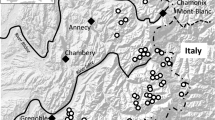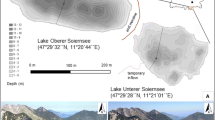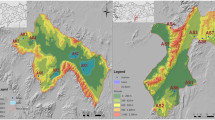Abstract
Benthic diatoms inhabiting littoral zones are regarded as promising bioindicators in lakes. Some pre-standard protocols were proposed and suggested to collect a single site per lake to assess its overall quality. In large lakes, such as Lake Geneva, a spatial heterogeneity of diatom assemblages was suspected, because of differing human pressures. Thirty-five sites were sampled along the shoreline in locations showing various population densities and crossed by rivers flowing into the lake. Different assemblages were found; one corresponded to more oligotrophic areas and was mostly situated on the shoreline next to low population densities; it was mostly composed of low-profile diatoms. A second one corresponded to more eutrophic areas and was mostly situated near densely inhabited areas; it was composed of many high-profile diatoms. A third one was in close vicinity to river inlets, with high abundances of motile diatoms. This last assemblage was spatially restricted to the river plume. After testing several diatom indices, one showed better capacities to assess nutrient level (EPI-L). If we avoid areas near river inlets, the ecological quality assessed with diatom indices ranged from moderate to high ecological status depending on the vicinity situated more or less near densely populated areas.




Similar content being viewed by others
References
Afnor, 2003. NF EN 13946. Qualité de l’eau - Guide pour l’échantillonnage en routine et le prétraitement des diatomées benthiques de rivières. Afnor: 1–18.
Afnor, 2004. NF EN 14407. Qualité de l’eau - Guide pour l’identification et le dénombrement des échantillons de diatomées benthiques de rivières, et leur interprétation. Afnor: 1–13.
Anneville, O. & J. P. Pelletier, 2000. Recovery of lake Geneva from eutrophication: quantitative response of phytoplankton. Archive für Hydrobiolgie 148: 607–624.
APHA, 1995. Standard Methods for Examination of Water and Wastewater, 19th ed. APHA, Washington, DC.
Barbiero, R. P., 2000. A multi-lake comparison of epilithic diatom communities on natural and artificial substrates. Hydrobiologia 438: 157–170.
Bennion, H., M. G. Kelly, S. Juggins, M. L. Yallop, A. Burgess, J. Jamieson & J. Krokowski, 2014. Assessment of ecological status in UK lakes using benthic diatoms. Freshwater Science 33: 639–654.
Berthon, V., A. Bouchez & F. Rimet, 2011. Use of diatom life-forms and ecological guilds to assess pollution in rivers: case study of south-eastern French rivers. Hydrobiologia 673: 259–271.
Blanco, S., L. Ector & E. Bécares, 2004. Epiphytic diatoms as water quality indicators in Spanish shallow lakes. Vie Milieu 54: 71–79.
Bolla, B., G. Borics, K. T. Kiss, M. N. Reskóné, G. Várbíró & E. Ács, 2010. Recommendations for ecological status assessment of Lake Balaton (largest shallow lake of Central Europe), based on benthic diatom communities. Vie Milieu 60: 197–208.
Cantonati, M. & R. L. Lowe, 2014. Lake benthic algae: toward an understanding of their ecology. Freshwater Science 33: 475–486.
Cantonati, M., G. Guella, J. Komárek & D. Spitale, 2014. Depth distribution of epilithic cyanobacteria and pigments in a mountain lake characterized by marked water-level fluctuations. Freshwater Science 33: 537–547.
Cellamare, M., S. Morin, M. Coste & M. Haury, 2012. Ecological assessment of French Atlantic lakes based on phytoplankton, phytobenthos and macrophytes. Environmental Monitoring and Assessment 184: 4685–4708.
Cemagref, 1997. Qualité biologique des eaux du Rhône et essai d’estimation d’effets toxiques sur les communautés de diatomées récoltées à l’aide de substrats artificiels. Agence de l’Eau Rhône-Méditerranée-Corse: 78 pages.
Coste, M., S. Boutry, J. Tison-Rosebery & F. Delmas, 2009. Improvements of the biological diatom index (BDI): description and efficiency of the new version (BDI-2006). Ecological Indicators 9: 621–650.
Cox, E. J., 1984. Observations on some benthic diatoms from North German lakes: the effect of substratum and light regime. Verhandlungen des Internationalen Verein Limnologie 22: 924–928.
Crossetti, L. O., C. Stenger-Kovács & J. Padisák, 2013. Coherence of phytoplankton and attached diatom-based ecological status assessment in Lake Balaton. Hydrobiologia 716: 87–101.
De Caceres, M., F. Oliva, X. Font & S. Vive, 2007. Ginkgo, a program for non-standard multivariate fuzzy analysis. Advances in Fuzzy Sets and Systems 2: 41–56.
De Caceres, M., P. Legendre & M. Moretti, 2010. Improving indicator species analysis by combining groups of sites. Oikos 119: 1674–1684.
DeNicola, D., 1986. The representation of living diatom communities in deep-water sedimentary diatom assemblages in two Maine (U.S.A.) lakes. In Smol, J. P., R. W. Battarbee, R. B. Davis & J. Merilainen (eds), Diatoms and Lake Acidity. Junk, Dordrecht: 73–85.
DeNicola, D. M. & M. G. Kelly, 2014. Role of periphyton in ecological assessment of lakes. Freshwater Science 33: 619–638.
Druart, J. C. & G. Balvay, 2007. Le Léman et sa vie microscopique, Editions Quae edn.
Ector, L. & F. Rimet, 2005. Using bioindicators to assess rivers in Europe: an overview. In Lek, S., M. Scardi, P. Verdonschot, J. P. Descy & Y. S. Park (eds), Modelling Community Structure in Aquatic Ecosystems. Springer, Berlin: 7–19.
Fore, L. S., 2002. Evaluating the biological condition of Bellevue streams using invertebrates and diatoms. Report, Statistical Design. Seattle, USA: 21 pages.
Forel, A., 1892. Le Léman tome 1, Edition rouge edn. Lausanne.
Jacoby, J. M., D. D. Bouchard & C. R. Patmont, 1991. Response of periphyton to nutrient enrichment in Lake Chelan, WA. Lake and Reservoir Management 7: 33–43.
Kahlert, M. & S. Gottschalk, 2014. Differences in benthic diatom assemblages between streams and lakes in Sweden and implications for ecological assessment. Freshwater Science 33: 655–669.
Kelly, M. G. & B. A. Whitton, 1995. The trophic diatom index: a new index for monitoring eutrophication in rivers. Journal of Applied Phycology 7: 433–444.
Kelly, M. G., L. King, R. I. Jones, P. A. Barker & B. J. Jamieson, 2008. Validation of diatoms as proxies for phytobenthos when assessing ecological status in lakes. Hydrobiologia 610: 125–129.
King, L., R. I. Jones & P. Barker, 2002. Spatial variation in epilithic algal communities around an oligotrophic and a mesotrophic lake in the English Lake District. Verhandlungen des Internationalen Verein Limnologie 28: 455–461.
King, L., G. Clarke, H. Bennion, M. G. Kelly & M. L. Yallop, 2006. Recommendations for sampling littoral diatoms in lakes for ecological status assessments. Journal of Applied Phycology 18: 15–25.
Krammer, K., 2000. The Genus Pinnularia. Gantner Verlag, Ruggell: 703 pages.
Krammer, K., 2001. Navicula Sensu Stricto, 10 Genera Separated from Navicula Sensu Stricto, Frustulia. Gantner Verlag, Ruggell: 526 pages.
Krammer, K., 2002. Cymbella. Gantner Verlag, Ruggell: 584 pages.
Krammer, K., 2003. Cymbopleura, Delicata, Navicymbula, Gomphocymbellopsis, Afrocymbella. Gantner Verlag, Ruggell: 530 pages.
Krammer, K. & H. Lange-Bertalot, 1986. Bacillariophyceae 1. Teil: Naviculaceae. Süßwasserflora von Mitteleuropa. Gustav Fischer Verlag, Stuttgart edn: 876 pages.
Krammer, K. & H. Lange-Bertalot, 1988. Bacillariophyceae 2. Teil: Bacillariaceae, Epithemiaceae, Surirellaceae. Süßwasserflora von Mitteleuropa. Gustav Fischer Verlag, Stuttgart edn: 610 pages.
Krammer, K. & H. Lange-Bertalot, 1991a. Bacillariophyceae 3. Teil: Centrales, Fragilariaceae, Eunotiaceae. Süßwasserflora von Mitteleuropa. Gustav Fischer Verlag, Stuttgart edn: 598 pages.
Krammer, K. & H. Lange-Bertalot, 1991b. Bacillariophyceae 4. Teil: Achnanthaceae. Kritische Ergänzungen zu Navicula (Lineolatae) und Gomphonema. Gesamtliteraturverzeichnis Teil 4. Süßwasserflora von Mitteleuropa. Gustav Fischer Verlag, Stuttgart edn: 437 pages.
Larras, F., A. Bouchez, F. Rimet & B. Montuelle, 2012. Using bioassays and species sensitivity distributions to assess herbicide toxicity towards benthic diatoms. PLoS One 7: e44458.
Larras, F., F. Keck, B. Montuelle, F. Rimet & A. Bouchez, 2014. Linking diatom sensitivity to herbicides to phylogeny: a step forward for biomonitoring? Environmental Science and Technology 48: 1921–1930.
Lazzarotto, J., P. Quetin & A. Klein, 2013. Physical–chemical changes in the water of Lake Geneva (major elements). In CIPEL (ed) Rapport sur les études et recherche entreprises dans le bassin lémanique, campagne 2012. Geneva: 16–59.
Le Thi, A. D., F. De Pascalis, G. Umgiesser & W. Wildi, 2012. Structure thermique et courantologie du Léman (Thermal structure and circulation patterns of Lake Geneva). Archives des Sciences 65: 65–80.
Lecointe, C., M. Coste & J. Prygiel, 1993. “Omnidia”: software for taxonomy, calculation of diatom indices and inventories managment. Hydrobiologia 269(270): 509–513.
Lods-Crozet, B. & J. B. Lachavanne, 1994. Changes in the chironomid communities in Lake Geneva in relation with eutrophication: over a period of 60 years. Archiv für Hydrobiologie 130: 453–471.
Marchetto, A., 2013. L’indice EPI-L pour l’évaluation de la trophie des lacs profonds par les diatomées benthiques. In Rimet, F., A. Bouchez & B. Montuelle (eds) Book of Abstract, 32ème colloque de l’Association des Diatomistes de Langue Française and 7th Central European Diatom Meeting, Thonon-les-Bains, France, 16–20 September 2013. INRA, Thonon-les-Bains: 53–55. ISSN 978-2-7466-6166-0.
Marchetto, A., C. Agostinelli, R. Alber, A. Behi, S. Balsamo, S. Bracchi, F. Buzzi, E. Carena, S. Cavalieri, F. Cimoli, S. Costaraoss, I. Crescentini, V. Della Bella, M. Di Brizio, M. Fioavanti, P. Fogliati, R. Fomenti, M. Galbiati, F. Galimberti, A. Macor, L. Mancini, S. Marcheggiani, G. Marchi, S. Musazzi, A. Nicola, R. Padula, S. Pozzi, C. Puccinelli, E. Rinaldi, C. Rustighi, P. Testa, B. Thaler, C. Vendetti & R. Zorza, 2013. 5. Indice per valutazione della qualità delle acque lacustri italiane a partire dalle diatomee epifitiche ed epilitiche (EPI-L). CNR-ISE, 02-13. CNR, Italy: 75–92.
Maruyama, A., K. Shinohara, M. Sakurai, T. Ohtsuka & B. Rusuwa, 2015. Microhabitat variations in diatom composition and stable isotope ratios of the epilithic algae in Lake Malawi. Hydrobiologia 748: 161–169.
Morin, S., M. Bottin, N. Mazella, F. Macary, F. Delmas, P. Winterton & M. Coste, 2009. Linking diatom community structure to pesticide input as evaluated through a spatial contamination potential (Phytopixal): a case study in the Neste River system (South-West France). Aquatic Toxicology 94: 28–39.
Ostendorp, W., C. Iseli, M. Krauss, P. Krumscheidplankert, J. L. Moret, M. Rollier & F. Schanz, 1995. Lake shore deterioration, reed management and bank restoration in some central European lakes. Ecological Engineering 5: 51–75.
Passy, S. I., 2007. Diatom ecological guilds display distinct and predictable behavior along nutrient and disturbance gradients in running waters. Aquatic Botany 86: 171–178.
Reavie, E. D., R. P. Axler, G. V. Sgro, N. P. Danz, J. C. Kingston, A. R. Kireta, T. N. Brown, T. P. Hollenhorst & M. J. Ferguson, 2006. Diatom-based weighted-averaging transfer functions for Great Lakes coastal water quality: relationships to watershed characteristics. Journal of Great Lakes Research 32: 321–347.
Rimet, F., 2012. Recent views on river pollution and diatoms. Hydrobiologia 683: 1–24.
Rimet, F. & A. Bouchez, 2011. Use of diatom life-forms and ecological guilds to assess pesticide contamination in rivers: lotic mesocosm approaches. Ecological Indicators 11: 489–499.
Rimet, F. & A. Bouchez, 2012. Life-forms, cell-sizes and ecological guilds of diatoms in European rivers. Knowledge and Management of Aquatic Ecosystems 406: 1–14.
Rimet, F., H. M. Cauchie, L. Hoffmann & L. Ector, 2005. Response of diatom indices to simulated water quality improvements in a river. Journal of Applied Phycology 17: 119–128.
Rimet, F., A. Bouchez & B. Montuelle, 2015. Benthic diatoms and phytoplankton to assess nutrients in a large lake: complementarity of their use in Lake Geneva (France–Switzerland). Ecological Indicators 53: 231–239.
Rosenberg, E. E., S. E. Hampton, S. C. Fradkin & B. Kennedy, 2008. Effects of shoreline development on the nearshore environment in large deep oligotrophic lakes. Freshwater Biology 53: 1673–1691.
Rouf, A. J. M. A., M. A. Ambak & S. M. Phang, 2009. The floristic composition and ecology of periphytic diatoms from the man-made tropical lake Tasik Kenyir, in Malaysia. Aquatic Ecosystem Health and Management 12: 364–374.
Round, F. E., 1960. Studies on bottom-living algae in some lakes of English Lake District. Journal of Ecology 48: 529–547.
Round, F. E., 1972. Patterns of seasonal succession of freshwater epipelic algae. British Phycological Journal 7: 213–220.
Round, F. E., 1981. The Ecology of Algae. Cambridge University Press, Cambridge.
Sastre, V., J. L. Loizeau, J. Greinert, L. Naudts, P. Arpagaus, F. Anselmetti & W. Wildi, 2010. Morphology and recent history of the Rhone River Delta in Lake Geneva (Switzerland). Swiss Journal of Geosciences 103: 33–42.
Scheuerell, M. D. & D. E. Schindler, 2004. Changes in the spatial distribution of fishes in lakes along a residential development gradient. Ecosystems 7: 98–106.
Snell, M. A. & K. A. Irvine, 2015. Importance of scalar and riparian habitat effects for assessment of ecological status using littoral diatoms. Ecological Indicators 25: 149–155.
Spitale, D., A. Scalfi & M. Cantonati, 2014. Urbanization effects on shoreline phytobenthos: a multiscale approach at lake extent. Aquatic Sciences 76: 17–28.
Stenger-Kovács, C., K. Buczkó, E. Hajnal & J. Padisák, 2007. Epiphytic, littoral diatoms as bioindicators of shallow lake trophic status: trophic diatom index for lakes (TDIL) developed in Hungary. Hydrobiologia 589: 141–154.
Stenger-Kovács, C., E. Lengyel, L. O. Crossetti, V. Uveges & J. Padisák, 2013. Diatom ecological guilds as indicators of temporally changing stressors and disturbances in the small Torna-Stream, Hungary. Ecological Indicators 24: 138–147.
Stevenson, R. J., J. T. Zalack & J. Wolin, 2013. A multimetric index of lake diatom condition based on surface-sediment assemblages. Freshwater Science 32: 1005–1025.
Thackeray, S. J., P. Noges, M. J. Dunbar, B. J. Dudley, B. Skjelbred, G. Morabito, L. Carvalho, G. Phillips, U. Mischke, J. Catalan, C. de Hoyos, C. Laplace, M. Austoni, B. M. Padedda, K. Maileht, A. Pasztaleniec, M. Järvinen, A. L. Solheim & R. T. Clarke, 2013. Quantifying uncertainties in biologically-based water quality assessment: a pan-European analysis of lake phytoplankton community metrics. Ecological Indicators 29: 34–47.
Torrisi, M. C. & A. Dell’Uomo, 2006. Biological monitoring of some Apennine rivers (central Italy) using the diatom-based eutrophication/pollution index (EPI-D) compared to other European diatom indices. Diatom Research 21: 159–174.
Vadeboncoeur, Y., M. J. Vander Zanden & D. M. Lodge, 2002. Putting the lake back together: reintegrating benthic pathways into Lake food web models. Bioscience 52: 44–55.
Vadeboncoeur, Y., S. P. Devlin, B. Peter & M. J. V. Zanden, 2014. Is there light after depth? Distribution of periphyton chlorophyll and productivity in lake littoral zones. Freshwater Science 33: 524–536.
Van Dam, H., A. Mertens & J. Sinkeldam, 1994. A coded checklist and ecological indicator values of freshwater diatoms from the Netherlands. Netherlands Journal of Aquatic Ecology 28: 117–133.
Acknowledgments
This study was involved in the IMPALAC Project financed by the French Ministry in charge of environmental affairs (MEEDDAT). The authors warmly thank M. G. Kelly is for his constructive review which brought new ideas to the manuscript and Professor Elliot Shubert for revising the English and scientific content of the paper.
Author information
Authors and Affiliations
Corresponding author
Additional information
Handling Editor: Judit Padisák
Electronic supplementary material
Below is the link to the electronic supplementary material.
Rights and permissions
About this article
Cite this article
Rimet, F., Bouchez, A. & Tapolczai, K. Spatial heterogeneity of littoral benthic diatoms in a large lake: monitoring implications. Hydrobiologia 771, 179–193 (2016). https://doi.org/10.1007/s10750-015-2629-y
Received:
Revised:
Accepted:
Published:
Issue Date:
DOI: https://doi.org/10.1007/s10750-015-2629-y




